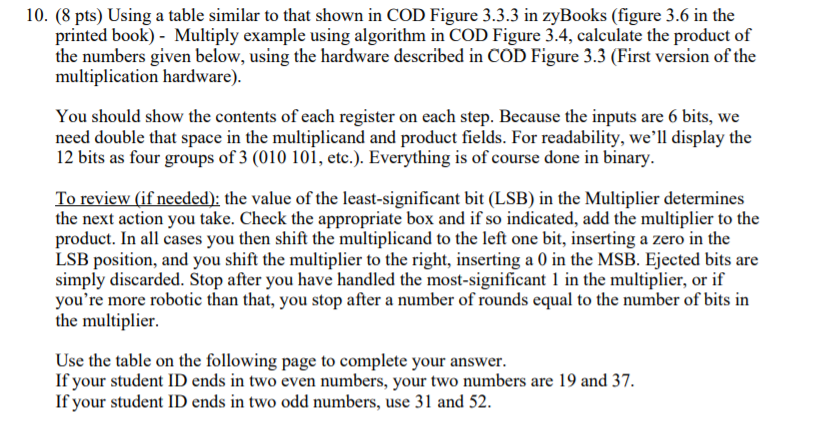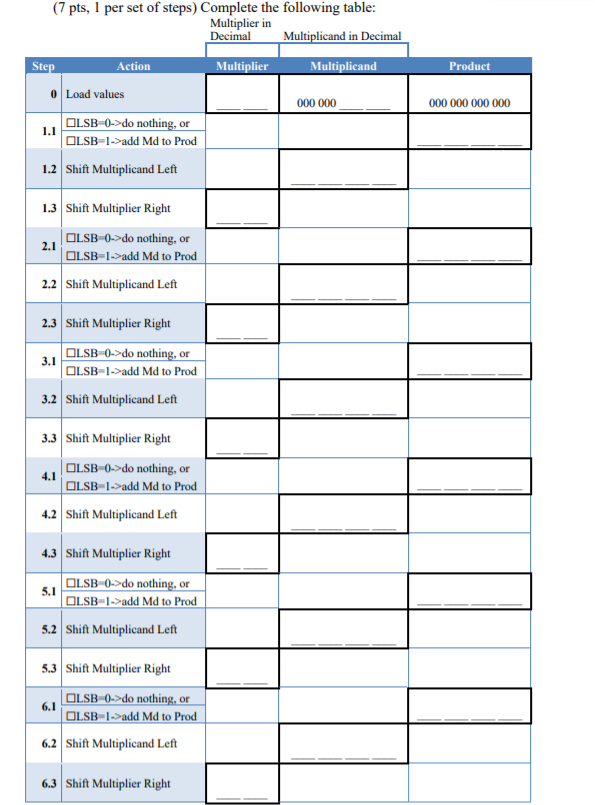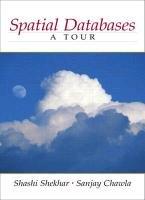Answered step by step
Verified Expert Solution
Question
1 Approved Answer
***USE 15 AND 22*** 10. (8 pts) Using a table similar to that shown in COD Figure 3.3.3 in zyBooks (figure 3.6 in the printed



***USE 15 AND 22***
10. (8 pts) Using a table similar to that shown in COD Figure 3.3.3 in zyBooks (figure 3.6 in the printed book) - Multiply example using algorithm in COD Figure 3.4, calculate the product of the numbers given below, using the hardware described in COD Figure 3.3 (First version of the multiplication hardware) You should show the contents of each register on each step. Because the inputs are 6 bits, we need double that space in the multiplicand and product fields. For readability, we'll display the 12 bits as four groups of 3 (010 101, etc.). Everything is of course done in binary the value of the least-significant bit (LSB) in the Multiplier determines the next action you take. Check the appropriate box and if so indicated, add the multiplier to the product. In all cases you then shift the multiplicand to the left one bit, inserting a zero in the LSB position, and you shift the multiplier to the right, inserting a 0 in the MSB. Ejected bits are simply discarded. Stop after you have handled the most-significant 1 in the multiplier, or if you're more robotic than that, you stop after a number of rounds equal to the number of bits in the multiplier Use the table on the following page to complete your answer If your student ID ends in two even numbers, your two numbers are 19 and 37. If your student ID ends in two odd numbers, use 31 and 52 If your student ID ends in an even followed by an odd number, use 15 and 22 For everyone else, your two numbers are 27 and 35. (1 pt) Using which number as your multiplier requires the least iterations? (7 pts, 1 per se (7 pts, 1 per set of steps) Complete the following table: Multiplier in Decimal Multiplicand in Decimal Ste Action Multiplier Multiplicand Product Load values LSB-0->do or LSB-l->add Md to Prod 1.2 Shift Multiplicand Left 1.3 Shift Multiplier Right LSB-0->do nothing, or OLSB-l->add Md to Prod 2.1 2.2 Shift Multiplicand Left 2.3 Shift Multiplier Right LSB-0->do nothing, or LSB-l->add Md to Prod 3.1 3.2 Shift Multiplicand Left 3.3 Shift Multiplier Right 41 | [ LSB-0->do nothing, or 4.2 Shift Multiplicand Left .3 Shift Multiplier Right OLSB-l->add Md to Prod LSB-0->do nothing, or LSB-l->add Md to Prod 5.1 5.2 Shift Multiplicand Left 5.3 Shift Multiplier Right LSB-o-do nothing, or OLSB 1->add Md to Prod 6.1 6.2 Shift Multiplicand Left 6.3 Shift Multiplier Right 10. (8 pts) Using a table similar to that shown in COD Figure 3.3.3 in zyBooks (figure 3.6 in the printed book) - Multiply example using algorithm in COD Figure 3.4, calculate the product of the numbers given below, using the hardware described in COD Figure 3.3 (First version of the multiplication hardware) You should show the contents of each register on each step. Because the inputs are 6 bits, we need double that space in the multiplicand and product fields. For readability, we'll display the 12 bits as four groups of 3 (010 101, etc.). Everything is of course done in binary the value of the least-significant bit (LSB) in the Multiplier determines the next action you take. Check the appropriate box and if so indicated, add the multiplier to the product. In all cases you then shift the multiplicand to the left one bit, inserting a zero in the LSB position, and you shift the multiplier to the right, inserting a 0 in the MSB. Ejected bits are simply discarded. Stop after you have handled the most-significant 1 in the multiplier, or if you're more robotic than that, you stop after a number of rounds equal to the number of bits in the multiplier Use the table on the following page to complete your answer If your student ID ends in two even numbers, your two numbers are 19 and 37. If your student ID ends in two odd numbers, use 31 and 52 If your student ID ends in an even followed by an odd number, use 15 and 22 For everyone else, your two numbers are 27 and 35. (1 pt) Using which number as your multiplier requires the least iterations? (7 pts, 1 per se (7 pts, 1 per set of steps) Complete the following table: Multiplier in Decimal Multiplicand in Decimal Ste Action Multiplier Multiplicand Product Load values LSB-0->do or LSB-l->add Md to Prod 1.2 Shift Multiplicand Left 1.3 Shift Multiplier Right LSB-0->do nothing, or OLSB-l->add Md to Prod 2.1 2.2 Shift Multiplicand Left 2.3 Shift Multiplier Right LSB-0->do nothing, or LSB-l->add Md to Prod 3.1 3.2 Shift Multiplicand Left 3.3 Shift Multiplier Right 41 | [ LSB-0->do nothing, or 4.2 Shift Multiplicand Left .3 Shift Multiplier Right OLSB-l->add Md to Prod LSB-0->do nothing, or LSB-l->add Md to Prod 5.1 5.2 Shift Multiplicand Left 5.3 Shift Multiplier Right LSB-o-do nothing, or OLSB 1->add Md to Prod 6.1 6.2 Shift Multiplicand Left 6.3 Shift Multiplier RightStep by Step Solution
There are 3 Steps involved in it
Step: 1

Get Instant Access to Expert-Tailored Solutions
See step-by-step solutions with expert insights and AI powered tools for academic success
Step: 2

Step: 3

Ace Your Homework with AI
Get the answers you need in no time with our AI-driven, step-by-step assistance
Get Started


